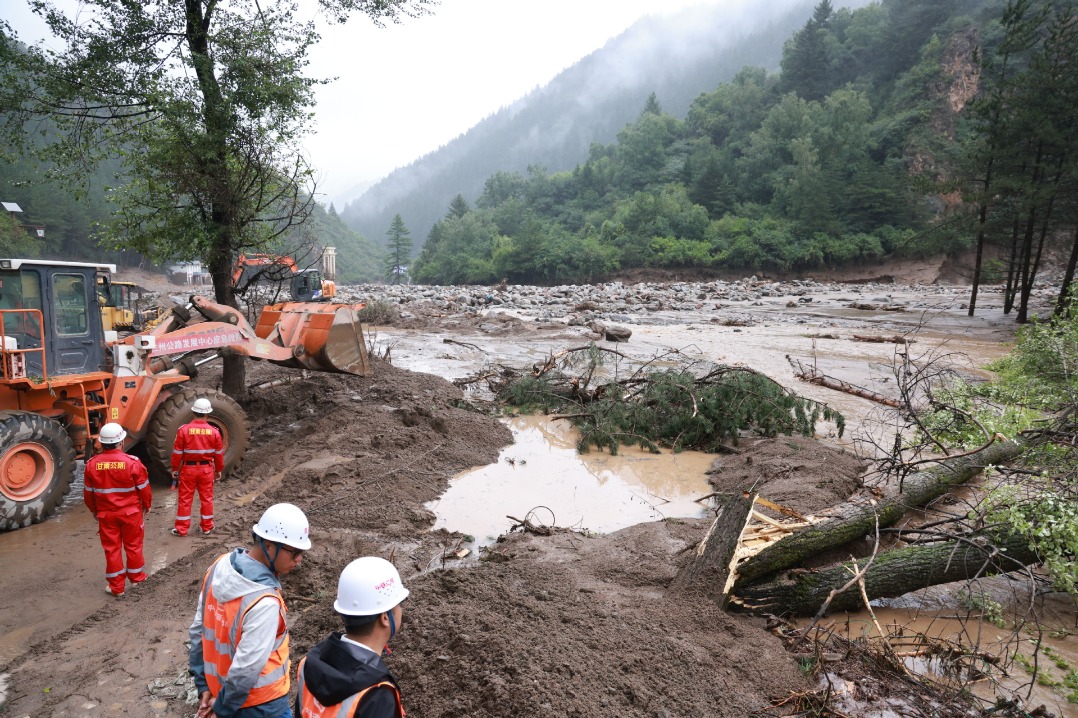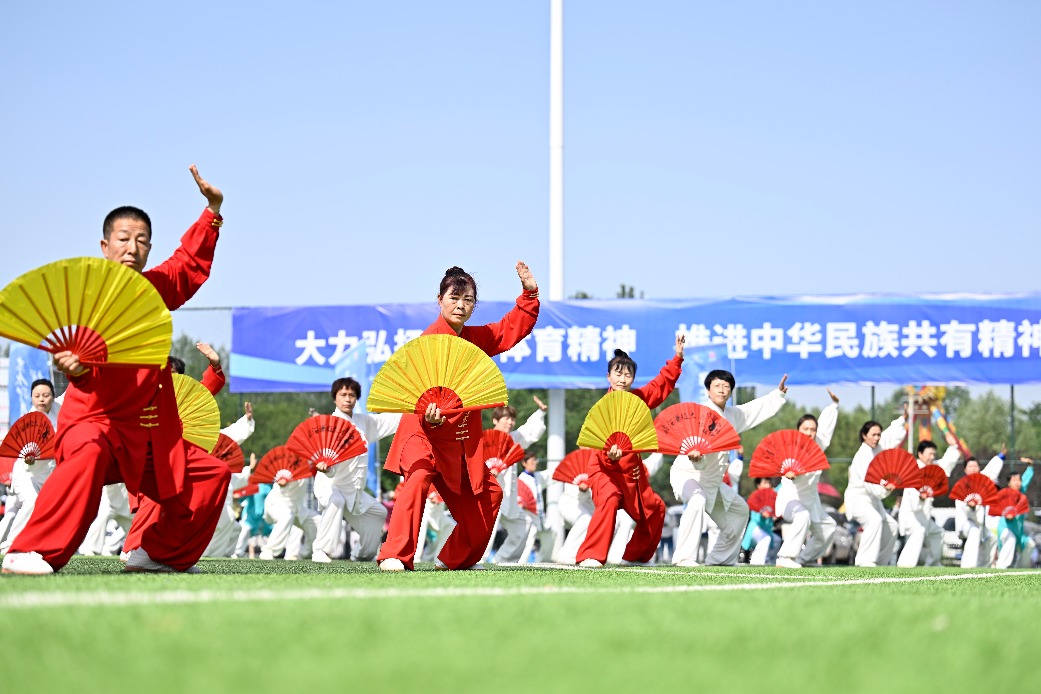Elephants will still tread when trains roll

A railway line that will transform Kenya is being sculpted into the land of the wild
As the Mombasa-Nairobi Standard Gauge Railway continues to be laid, its builders are paying heed to the needs of one constituency that will be affected by the new link: the animals that live in areas through which the line will pass, including one of Kenya's national parks.
The builder, China Road and Bridge Corporation, says it has been taking steps to minimize the impact of the line, and in that effort has engaged the help of the Kenya Wildlife Service.
| Elephants forage in Tsavo National park. Tony Karumba / AFP |
| Workers at a construction site of the Mombasa-Nairobi Standard Gauge Railway in Kenya. Pan Siwei / Xinhua |
| People destroy a trap used for capturing wild animals at the Tsavo National park in Kenya. Meng Chenguang / Xinhua |
| The construction site of a bridge in Tsavo National Park. Pan Siwei / Xinhua |
Strict rules have been set down relating to the railway line and its effects on ecology, and the company's environmental engineers and Kenya Wildlife Service officers have been deployed to monitor construction work.
Culverts and bridges are being built in parks to ensure that animals can move about unimpeded. That has added to the cost of the project, but company and Chinese government officials say it is money well spent.
"Despite the extra effort involved, which not only increases costs but adds to the difficulty of construction, we are resolute in our determination to look after Kenya's environment, including its wildlife," said China's ambassador to Kenya, Liu Xianfa, as he accompanied Kenyan President Uhuru Kenyatta on an inspection tour at the construction site of a bridge in Tsavo National Park.
"This demonstrates the way that not only Chinese companies think, but also the way the Chinese government thinks, too."
The park, consisting of Tsavo East and Tsavo West, is the largest national park in Kenya and one of the largest in the world. It boasts of one of the most evocative images of Africa, dust-red elephants wallowing, rolling and spraying each other in the midnight blue waters of the palm-shaded Galana River.
Anyone walking along the railway line will be able to see many bridges and culverts, Liu said.
"It shows that the Chinese company attaches great importance to environmental protection, wanting to look after the beautiful things that all mankind cherishes."
China Road and Bridge Corporation says there are about 170 culverts and 20 bridges in Tsavo National Park, with their total length a little less than 6 kilometers. Nine of the bridges are being built especially for the convenience of animals.
George Bagwasl, the company's environmental health and safety officer on the project's sections three and six, says culverts, about five meters high, will be built every 500 meters in the section that passes through the park.
Bagwasl says the company has contacted the Kenya Wildlife Service "anytime when we feel we need to consult with them on issues of design" and has made a great effort to "leave Tsavo National Park as natural as possible".
"The design of the project has been done in a manner to suit the wildlife corridor. And of course, we are not the ones managing the park, and we are unaware of the animal routes and other things related to animal movements, habitation and such things. So all of these things we do in consultation with the Kenya Wildlife Service.
The company and the wildlife service consult on things as minor as grass on slopes to prevent erosion, he says.
Erustus Kanga, senior assistant director of biodiversity research and monitoring for the wildlife service, who is responsible for monitoring the company's work in the national park, says: "We work with them every day. Right now I was on the phone talking to them. Every day we are on the phone for an hour or so.

"They call us when they are putting in bridges so we can go and inspect on the site and agree that it is OK. If they have any other issues in the park and they want to inquire, they always have to ask us."
The wildlife service has deployed more than 80 personnel to help the company in its work "just to make sure our contractor is able to comply", Kanga says.
"We don't want to penalize the contractor; we want to guide the contractor. Nothing has started yet. We are still in close talks, because right now they are still doing preparation. When the railway is completed, that is when we assess its impact."
Measures will be taken to ensure that poachers cannot take advantage of modified animal movements as a result of the railway line, its culverts and its bridges, he says.
Judy Wakhungu, cabinet secretary for environment, water and natural resources, lauds the efforts the company and the wildlife service are making to protect the environment as the railway is built.
"You need to actually see what the standard gauge railway looks like. You have to go to Tsavo National Park because that is where it is actually being developed. And you can see the efforts not only in fostering development but also of maintaining the environment."
There is an overpass in "areas that are critical to conserving the wildlife" under which elephants can pass, she says.
However, there are also some difficulties. While Kenya Wildlife Service is "monitoring the whole process keenly to ensure that the environment is not shortchanged, there are also other challenges such as environmental management", she says.
"We have seen that sand harvesting has escalated to a point where we need to be more vigilant and work closely with the counties to ensure that we do not cause undue damage to the environment, so we are trying to balance things.
"The beauty about Kenya is that we have a very vigilant civil society that keeps us in check. So when we are giving out the contracts, we inform them about the guidelines."
Solomon Ouna, technical adviser on the standard gauge railway with Kenya Railways Corporation, says he is optimistic about the effects of the line and says the animals will not be "greatly affected".
"We have built large, long bridges under which animals can pass easily and migrate, so the animals may not even notice, and their normal way of life will not be greatly affected.
"In this country, we are short of infrastructure. And personally I would not like to place any challenges in the way of realizing our transport infrastructure, where in going through Tsavo National Park you make the thing so expensive. Yes, animals require their way, but like human beings they can adjust."
Contact the writers at houliqiang@chinadaily.com.cn
Lucie Morangi contributed to this story.
(China Daily Africa Weekly 07/17/2015 page16)
Today's Top News
- Xi says China will continue to promote peace talks in Ukraine crisis
- Leaders of over 20 countries to attend SCO Tianjin Summit
- Xi urges all-out rescue efforts following mountain torrents in Gansu
- A Quixotic quest to reindustrialize US
- Grassroots sports events promoting nation's fitness goals
- Major test brings lunar mission closer to reality


































